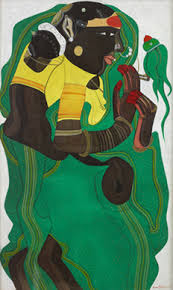The year was 1991. The place was Igatpuri, 120 km away from Mumbai. I spent ten days there in a
retreat undergoing arya maun, i.e.,
observing golden silence all through. My first brush with Buddhism was via Vipassana meditation.
The lingering memory of my Igatpuri stay was the fluttering colourful flags and the chiming tiny
bells. The sweet sounding bells were supposed to aid the long hours of deep
meditation.
I was intrigued by the lack of God concept in Buddhism. I wondered whether people
would feel comfortable without the ‘father’ figure though I got convinced later
that it was quite possible.
Decades passed by, and after I got retired, I had the sudden
urge to visit a Buddhist Monastery to
stay with the bhikshus for some time.
In the meantime, I had made a trip to North East and visited Ramtek and other Buddha Vihaars. The pristine Nature surrounding the monasteries,
the stillness of the place, the quiet dignity of the people and the colour
strewn all over attracted me. It was like walking inside a dream.
I thought of making a beeline to Dharmasala to spend a month or so there. Senior Buddha bhikshus, westerners all, were conducting workshops. There was
the additional bonus of meeting the Dalai Lama as he used to handle one-day
sessions in between. However, the journey was difficult. At the age of 61 with
diabetes and difficulties in bowel movements, I was doubtful whether I could
make the trek all alone. Moreover, I had to pay up for my sojourn. There was a
minimum fee prescribed. It was unexpected as I had not come across such a poser
anywhere else. Even at Igatpuri,
after ten days of learning, boarding and lodging I was absolutely free to make
an exit without any sort of bother.
So, I chose the lesser option, to visit the nearest Buddha Vihaar for a couple of days, get
the feel of the place, befriend the monks, have their food and get out of the
way!
The search narrowed down to Namdroling Monastery. 88 km away from Mysore, Karnataka.
However, there was a problem. The entire area of the Tibetan
settlement is a protected place and one needed a special permit (PAP) from the
Ministry of Home Affairs, New Delhi for the stay in protected areas. I had once
got it for visiting Minicoy (in 2003)
and the procedure was fairly easy. All it required was a visit to the
Lakshadweep Administration Office in Kochi. The Namdroling case was different with Application forms, passport
copies, local reference etc. and it might take around a month.
Again, I took a wise decision. I decided to stay at Kushal Nagar, a small time town nearby.
Just six km away from the Golden Temple (at Namdroling),
Kushal Nagar is full of auto-rickshaws
and modest hotels.
The Monasteries open to visitors from 7 am to 6 pm.
 |
| Namdroling Monastery - Main entrance |
I reached the Golden Temple early in the morning. There was no
entry-fee. I entered the compound. The residential quarters of student-monks
come first and by the side of it, the College buildings. There are six large
monasteries and two Universities spread across the settlements. Five thousand
students, all Buddhist monks, are enrolled. The total population of area is
70,000 odd.
The Golden Temple is an imposing building.
The dimensions may be similar to a modern auditorium with
thousand seats. There is a foyer-like structure in front of the main hall, open
on three sides. Intricate carvings and
exquisite murals are on the walls and ceilings. It’s an assault of colours on your
senses! The main hall too is decorated with paintings of gods and demons but
you are almost simultaneously arrested by the sheer radiance of three golden
statues – Buddha flanked by Padmasambhava and Amitayush, each sixty feet tall. The eyes are a bit different with
a glimpse of awe, a no-nonsense look about them. You can squat on the marble
floor but chances are that you won’t be left in peace. The flurry of visitors,
all of them busy with taking selfies and caring a damn for the sanctity of the
place bother you. At times the noise from the crowd is quite annoying.
There is a beautiful garden outside with manicured lawn and
fountains. You can settle yourself under one of the trees and watch the antics
of tourists. Or, you can visit three more temples in the same compound, one of
which keeps the relics in a casket like structure. Poojas are non-stop there
with monks meditating in a separate enclosure.
While strolling around I was caught unawares by the loud
sound of prayers emanating from the prayer hall just outside the Golden Temple.
I was familiar to Tibetan Meditation Music but this one was quite different.
The accompanying instruments, bowl-shaped drums, kombu like wind-instruments (of Kerala), cymbals and conch shells
are not the kind of ensemble one would expect for Buddhist chants. Only the
junior monks played them and seniors were conspicuous by their absence. I tried
to make an entry into the hall but politely turned back.
(continued)
**********



